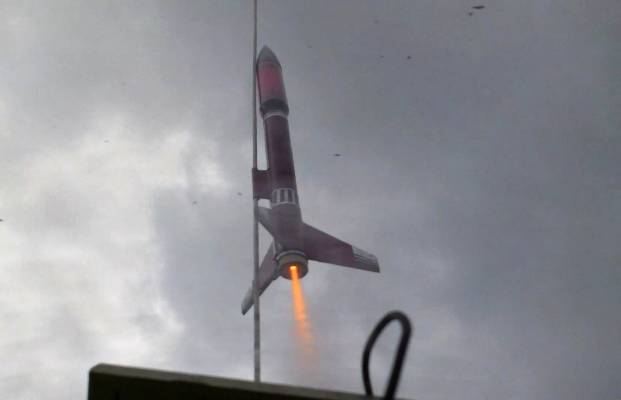The Gamma-Ray: My first Quest kit. It features a translucent red payload tube, three swept fins, and plastic nose cone and transition section. The fin stock is pretty thick and sturdy, and I like the Kevlar shock cord supplied with the kit. I painted it high-gloss metallic red with silver (stick-on) decals. I also added extra silver foil stickers to really make this model shine. I had to add a lot of nose-weight to balance this model on a string stability test, but now it flies very well - very straight. The nose-weight was glued in to the tip of the plastic nosecone, so I still have full use of the payload bay. The payload tube has vent holes added for a barometric altimeter. It can get pretty far up there with B and C motors. I bought this kit cheap as part of a package deal on eBay, didn't give it much respect. But it consistently flies well and it is growing on me. I would recommend this model, but defiantly string-stability test it with a C motor and add nose-weight as necessary, or you'll probably be very sorry you didn't. Its light enough to fly very high, but the supplied 14-inch parachute is too large unless you really pack the ounces into the payload. Even with a 18 gram payload and a 1-1/2 inch spill hole cut into the chute, it still descends at only 5 mph, allowing the wind to take it pretty far. The material Quest uses for parachutes also seems very light but too stiff, and often it will not unfurl even when plummeting down at about 30 mph. I now use a 12” Estes parachute. The other advantage of a smaller chute (aside from getting lost) is that it's easy to pack into that small, 13mm body tube. I can easily get beyond 800 feet with a C6-7 in this. This rocket has flown higher than the Rennaissance Tower in Dallas, TX and the Charlotte Bank of America Corporate Center. It could easily look down at the Trump World Tower in NY.
| Flight Date: | 2012-04-01 |
| Rocket Name: | Gamma Ray |
| Kit Name: | Quest - Gamma Ray {Kit} (2004) [1994-] |
| Flyer's Name: | Rich DeAngelis |
| Motors: | B6-4 |
| Launch Site: | Penn Manor School Lancaster PA |
| Actual Altitude: | 375 Feet |
Ideally, a B6-6 is best for this light rocket, but in the stronger, gusty winds I expected a lot of weathercocking and a lower apogee, so I chose the -4. After the A8 flight failed parachute deployment, I thought a B6 would give it plenty of time to open, but not so. This second attempt at testing the 1-inch spill hole in the parachute did not work either, even though it was above 50 degrees F.
The B6-4 motor burned for 8/10 seconds, accelerating the rocket at 5.4 Gs, peaking at 14.6 Gs. It reached a top speed of 98 mph. These typical performance numbers exactly matched a B6-4 flight five months ago. No strong gust arrived, so this rocket continued straight up during the 4 second coast. Still rising, the ejection fired a bit early at 366 feet, and stopped the rocket at an altitude of 375 feet 6/10 of a second later.
Again the parachute failed to open up, and the rocket fell the 375 feet at 22 mph, landing in the grass undamaged 15.8 seconds after liftoff, instead of the expected 45 seconds.
| Stage | Motor(s) |
|---|---|
| 1 | Estes B6-4 |
 |
 |
